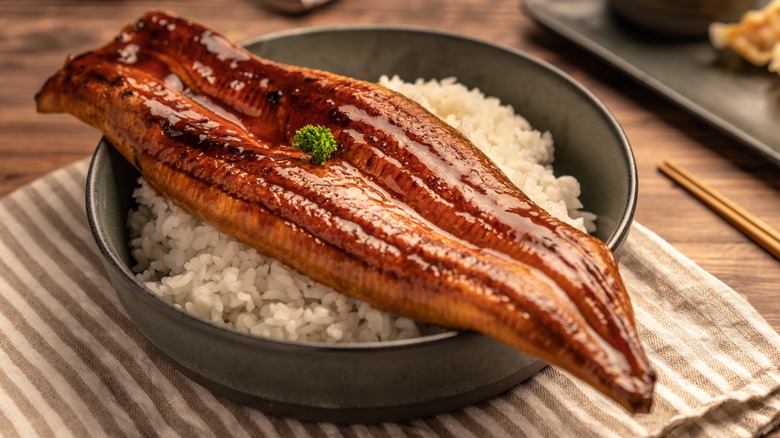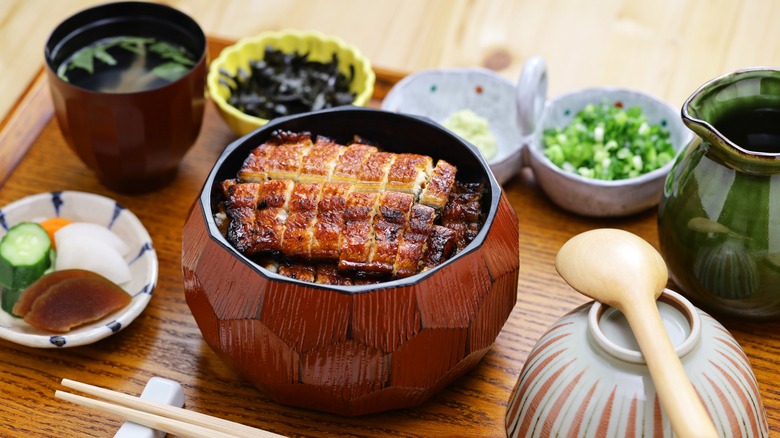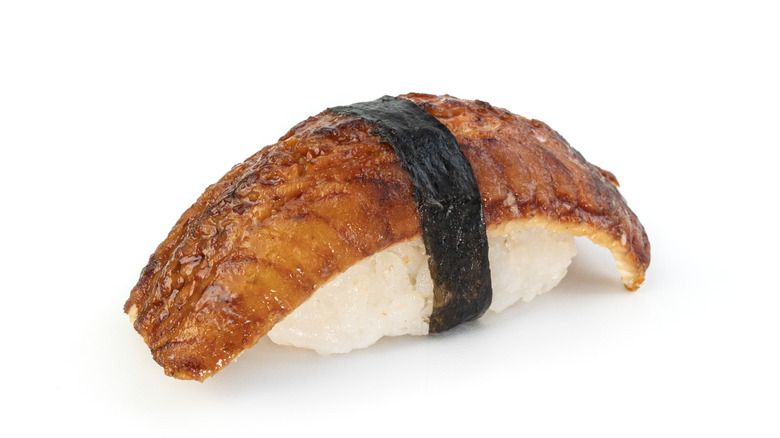What Is Unagi And How Is It Best Cooked?
Fish come in all shapes and sizes, but few look as unique as eel. These long and slender creatures are numerous in species, inhabiting both ocean and river ecosystems. In Japan, eels from both biomes are commonly enjoyed at the dinner table. However, for an especially tasty variant, turn to unagi.
The name refers specifically to the Anguilla japonica species, which inhabits a freshwater setting, but breeds in the ocean. While poisonous when raw, these eels are delicious when prepared carefully. Their fatty texture combined with gentle flavor makes them stand out among both other eel and fish varieties, owing to their popularity. And especially when dressed with a sweet, soy-based eel sauce, they make for a tasty accompaniment to rice. Plus, they're commonly sold already smoked and covered in a delicious sauce — making utilizing them in the kitchen a breeze. Let's dive into the details of how they're harvested and prepared.
How unagi is harvested
Unagi is sourced from both farm-raised and wild environments, with the latter experiencing scarcity issues. Commercially growing the eels from birth to harvest is difficult; the fish will eat each other in confined spaces, which makes yields very low. As a result, many eel fisheries will catch young eels on their journey upriver from the Pacific and then transfer them to a carefully monitored reservoir. However, new advances in breeding technology have allowed for the proliferation of eels from egg to consumption. Nevertheless, wild eels continue to be regarded for their more flavorful taste and better texture.
Eels raised in Lake Hamana are especially regarded for their taste. Global demand, especially in sushi restaurants, has pushed certain kinds of eels to near extinction. Prices for unagi have increased, and even Japan has turned to importing eels from abroad. As a result, make sure to verify your purchased unagi is sustainably sourced — and consider turning to another species. New eel farming initiatives are starting in the U.S., offering a similar taste to unagi but with less ecological strain.
How unagi is prepared
Once harvested, unagi is traditionally prepared with a technique known as kabayaki. The eel is gutted and then sliced in half, with the skin still intact. It's then carefully filleted and butterflied. Next, it's cut into rectangular sections, which is the most common way that unagi is served. The eel is then covered in a unagi sauce, made from mirin, soy sauce, sake, and white sugar. Some recipes then steam the eel, while most skewer it and immediately grill it.
In addition to grilled unagi, the eel is also commonly smoked. This cooking method is also common for other species of eel but designed to mimic the unagi palette. There are several ways you can smoke an eel including butterflying it. Typically, smoked eel is brined for several hours before being cooked in a smoker at 140 F. Commercially available smoked eel is typically preserved in a sauce that allows it to last for a longer period of time. Here are some common unagi applications.
Common dishes with unagi
Unagi's high-fat content, paired with the delicious, sweet sauce, makes it especially tasty when accompanied with rice. Several unagi rice dishes are commonly consumed in Japan. When served in a rectangular box with freshly cooked white rice, the eel dish is called unaju. Typically, it's accompanied by a clear soup made from the eel's organs. A simpler take is unadon, which is a circular rice bowl with eel. For an extra peppery kick, both dishes are typically served with a dash of spicy sansho pepper.
Unagi is also a common fixture in sushi restaurants. The eel — which is usually already barbecued in the unagi sauce — is served in individual nigiri pieces. It's wrapped in a small sliver of nori and accompanied with cucumber. Since the fish is tastier when warm, it's typically blow-torched before serving. It's also frequently integrated into rolls, a popular option for cooked sushi. No matter the application, unagi's appeal is clear. With tasty flesh and an accompanying delicious sauce right in the package, it's poised for tasty applications.



